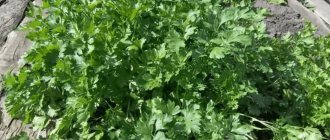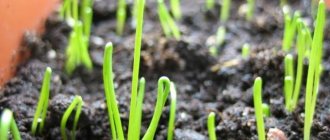Is it possible to plant dill before winter and when to do it? Experienced gardeners claim that in this case dill sprouts faster, grows better and produces a good harvest. Is it so? If you look at it, the famous spice belongs to the cold-resistant, long-day crops.
With proper sowing, dill seeds will calmly survive the winter, withstand March frosts without consequences and sprout vigorously in early spring, 10-15 days earlier than spring sowings.
What varieties of dill can be sown in autumn?
Garden dill comes in three types:
- Ordinary. The plant has a single stem with numerous leaves. An umbrella with seeds is formed at the top.
- Bush . At the base of the main stem, 5-6 internodes are formed, from which lateral stems develop.
- Densely leafy. The plant has one stem, but due to the large number of leaves, this dill resembles a small Christmas tree.
In these three categories, breeders have developed a great variety of varieties and hybrids with different ripening periods and distinctive characteristics. Before winter, dill of any variety is planted, but to achieve the best results, preference should be given to varieties with increased frost resistance, early and medium ripening periods:
- Kharkovsky 85;
- Atlant;
- Ambrosia:
- Shmaragd;
- Umbrella;
- Gribovsky:
- Vologda lace;
- Grenadier.
Fresh greens from the listed varieties are harvested 30-45 days after germination.
How to choose the time for autumn planting before winter and when to prepare the beds
The timing of autumn sowing of dill depends on the climate of the region and weather conditions of the current period. If the autumn is too warm and the seeds are sown early, the seeds may germinate. The optimal sowing time is considered to be days when the daytime air temperature is within 0-3°C:
- in the Moscow region: in November;
- in Siberia and the Urals: in mid-late October;
- in the south: in the second half of November – early December.
If for spring sowing the beds and the soil on them are prepared in the fall, then for winter dill the planting site is prepared in the summer, in mid-July - early August.
Conditions for favorable growth
In general, dill is an unpretentious plant and in many areas it grows like a weed, seeding itself and growing independently every spring. But this applies to early varieties, the seeds of which have time to ripen over the summer.
For bush varieties or when planting dill in open ground with seeds, it is better to take into account the optimal requirements of agricultural technology:
- The air temperature is at least +3 C (daily average, but tolerates temporary frosts well).
- Warming up of the earth - from 3 to 6 C.
- The amount of sunlight is 10-14 hours.
- Watering is frequent, in hot weather (drought) 2 times a day.
- Top dressing - mineral, nitrogen fertilizers (well-fertilized bed, fertile soil).
- Application of fertilizers after sowing - after 7-10 days, nitrogen-containing compounds (8-10 g of ammonium nitrate per 1 m2 or watered with a manure solution).
Advantages and disadvantages of autumn planting
Planting dill in the fall before winter has many advantages:
- the seeds will sprout 10-15 days earlier than spring sowings;
- there is no risk of seeds freezing;
- strong and friendly shoots;
- plants will have stable immunity to diseases and adverse factors;
- saving time on other work in the spring;
- the opportunity to collect several harvests of greenery per season.
No significant disadvantages of the method were identified. There are certain risks that many gardeners consider disadvantages:
- in unstable weather (sudden thaw in autumn) and inaccurate forecasts, there is a risk of untimely seed germination;
- increased seed consumption (20-30% more);
- the probability of seedling death in the spring due to recurrent frosts.
Features of caring for seedlings in spring
After the snow cover melts and the sun's rays begin to warm the soil, the first shoots of seedlings are observed. To speed up the process, gardeners cover the beds with agrotextiles or stretch films. The covering material is removed after the night frosts cease.
Caring for dill seedlings in the spring involves loosening the soil between the rows and controlling weeds. Water the seedlings as the soil surface dries.
The nuances of growing and caring for herbs:
- bushes with fragrant foliage require moderate watering. It is worth remembering that the crop does not tolerate stagnation of moisture in the soil;
- Timely weeding of beds with green pets contributes to the intensive development of vitamin culture. If you do not keep the plantings clean, weeds can choke out the fragile sprouts of young dill;
- dense plantings will cause poor growth of seedlings. It is important to thin out plants to provide free space for both root development and vegetative mass growth;
- regular weeding and loosening after rain allows you to maintain the soil in a favorable condition;
- the spicy crop cannot be treated with chemicals, since the plant will not be able to free itself from harmful compounds by the time of consumption;
- It is recommended to allocate a place for growing dill and other spicy herbs away from the vicinity of fruit trees and berry gardens, the agricultural technology of which involves the control of pests and diseases using chemicals.
3 weeks after the sprouts appear, dill bushes appear as rosettes 20-25 cm high with characteristic openwork leaves with a pleasant, delicately pungent aroma. They are cut at a level of 2-3 cm from the soil surface. Bush varieties of greens are subject to repeated cutting, so it is beneficial to grow them to constantly have a fresh portion of aromatic crops in the garden. When harvesting a vitamin crop, sprinkling is first carried out, after which the openwork branches on the rosette are trimmed. It is important that the dill roots remain in the soil to form new green mass.
Experienced gardeners claim that it is best to sow dill in the fall, since dill sown in the fall germinates better, grows faster and produces a good harvest. There is some truth to this, since dill is indeed a cold-resistant, long-day crop.
If you choose the right sowing date when sowing dill, your chances of getting a good harvest increase. Dill seeds sown in autumn tolerate low temperatures well and sprout in early spring, about 10-15 days earlier than dill sown in spring.
How to plant dill in the fall before winter
Winter sowing is somewhat different from traditional spring sowing. Knowing the secrets and subtleties of autumn planting, you can avoid many problems, because of which summer residents often abandon this method of growing.
Selecting a location
Dill prefers places well lit by the sun throughout the day (minimum duration of bright light - 12 hours), and soil rich in organic matter, light and neutral in acidity . It is difficult to grow lush emerald greens in acidic and poor soil. Such lands are cultivated in advance.
When choosing a place for dill, it is important to observe crop rotation. The best predecessors for it are cucumbers, early potatoes, tomatoes, radishes, white cabbage and cauliflower. You can’t sow dill after plants of its own Apiaceae family: cilantro, carrots, cumin and fennel.
Important! A bed brightly lit by the sun for a long time is required for winter dill. The snow will melt there faster than other places, the soil will warm up and seedlings will appear.
Seed preparation
The seeds are sown dry before winter. No pre-treatment, soaking or other pre-sowing procedures are needed. The seeds must be fresh: if they are collected from your own garden, then definitely this year.
Preparing the bed
Before you start preparing the soil for a crop, it is important to know exactly which soil, in terms of nutritional value and mechanical composition, predominates in the garden. To determine this in the field, there is such a test. Take a handful of earth and squeeze it into a fist.
If a soil lump easily falls apart into grains when you press on it, you have sandy loam soil. Soil with a high clay content is slippery and greasy to the touch. You can easily roll it into a sausage.
The acidity of the soil is indicated by weeds growing on it. Indicators of very acidic soils are:
- field navel (one of the wild types of chamomile);
- blueberry;
- heather;
- sorrel;
- horsetail.
Having determined the type of soil and its acidity, two weeks before sowing, begin the following activities:
- The soil is dug up using a shovel and the weed rhizomes are removed.
- At the same time, it is limed (2-3 kg of lime for every 10 sq. m) and a complex of fertilizers is added (rotted manure, sifted wood ash, superphosphate and potassium chloride) - 20-30 g per 1 sq. m. m.
- Use a rake to level the soil well, breaking up all lumps.
Attention! Manure or compost applied to the soil must be completely rotted, otherwise the weeds will kill the seedlings.
Sowing pattern and depth
Dry seeds are sown in the soil according to the following scheme:
- embedment depth - 3 cm;
- distance between rows - 10-15 cm;
- the distance between plants is 0.51 cm.
Other rules
Such a large depth of seed placement is not accidental. It is advisable that 1.5 cm be fertile soil, and the other 1.5 cm be a warm mulching layer. Peat, dry manure crumbs, and sawdust from deciduous trees are used as mulch for dill. Mulch not only retains heat and protects from frost, but also prevents the formation of soil crust after the snow melts.
Have you prepared a bed, but didn’t have time to sow—it snowed? No problem! You can also sow in December, during the first thaw. Lightly scatter 2-3 cm of snow, sow the seeds directly on the snow cover and cover with a layer of snow.
Seed preparation
Before sowing dill, you should prepare the seed material. There are several ways to prepare seeds for planting. The simplest of them is to rinse and soak in water for a day to swell. You can add wood ash or other universal fertilizer to the water. The temperature of the soaking liquid should be 20-25 degrees.
Another preparation method involves burying the seeds in damp, unheated soil at a shallow depth 2 weeks before sowing. The seed must first be dried and placed in a fabric bag. Before sowing, the seeds should be spread on paper and dried until scattered.
How to care for dill planted in the fall before winter
Unpretentious dill does not require extensive care. For a bountiful harvest, the seeds need to be properly wintered so that they do not rot or freeze. The choice of mulching and covering material depends on the winter temperatures of the region and the level of groundwater in the area.
The best material suitable for covering crops in any region is considered to be agrofibre, and peat mulch on top of it.
In the spring, when seedlings appear, crop care includes the following mandatory agricultural practices:
- Regular watering. It is important not to allow the top layer of soil to dry out. The frequency of watering is 1 time a day, on hot days - 2-3 times.
- Root feeding. Organic matter such as bird droppings or manure is used as fertilizer. For lush greenery, 1-2 feedings are enough for the entire growing season of the plant.
- Weeding of weeds. Weeds are the worst enemies of any green crop. Capable of active growth, they deprive cultivated plants of the necessary space in the sun and nutrients from the soil.
- Shelter on hot days from direct sunlight. Young dill shoots are very tender. If the weather is abnormally hot in the spring, canopies made of gauze or thin white lutrasil are built over the beds.
- Protection against pests is possible only with the help of traditional methods of control. To repel harmful insects, sprinkle the greens with tobacco dust or dry garlic powder mixed with sand in a 1:1 ratio.
Climate nuances in the region
Before sowing dill, you need to sort out all the climatic features, since the conditions in this region are very different from the middle zone and warmer southern regions. To get a good harvest, it is important to foresee all possible problems and carry out the work correctly. The main differences are:
- The climate in the area is temperate, ranging from continental to oceanic. Summers are moderately warm, often cool, winters are mild, but there can be significant drops in temperature for several days or weeks.
- The main difference between the weather is its variability, since this region is affected by different air masses. Humid air comes from the sea, causing warming in winter and, on the contrary, cool periods in summer. Continental currents bring cold temperatures in the winter months and heat in the summer months. Arctic masses always provoke a drop in temperature.
- Temperatures can drop sharply, and even in summer there are frosts. The differences are up to 20 degrees per day.
- Due to the large area, conditions vary in individual areas. It is necessary to take into account all the features of the place where the dill will be planted.
- There are often strong winds and rain. There can be a lot of precipitation, which is dangerous due to flooding of plantations and their death.
- In winter, during prolonged thaws, the seeds get wet; if it gets colder sharply, they will die.
- Late spring. The snow melts until mid-April, so seedlings appear most often in May; during this period there is a danger of return frosts.
To eliminate the possibility of flooding, plant dill in high beds.
Harvest and storage
Depending on the variety chosen, it takes from 25 to 50 days to grow fresh winter greens. Cutting dill begins at a height of 7 cm. If you grow greens for sale, wait until the height is 20-25 cm. The entire crop is harvested at once or as needed.
The collected greens are used for food and stored briefly in the refrigerator. For long-term storage, dill is dried or frozen. For freezing, the greens are washed to remove dirt and finely chopped. It is convenient to freeze the spice in ice containers to add portioned cubes to various dishes.











